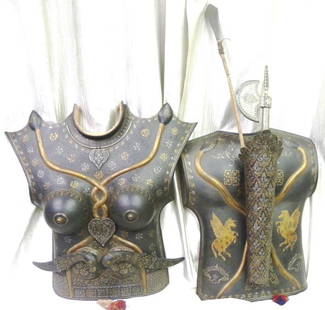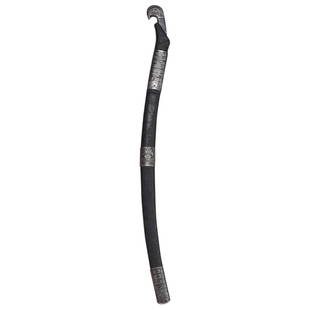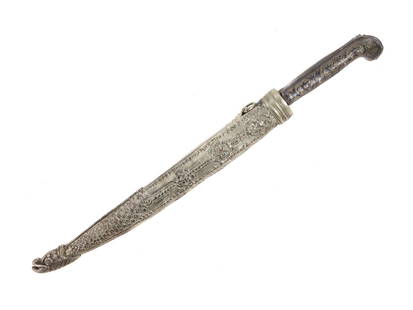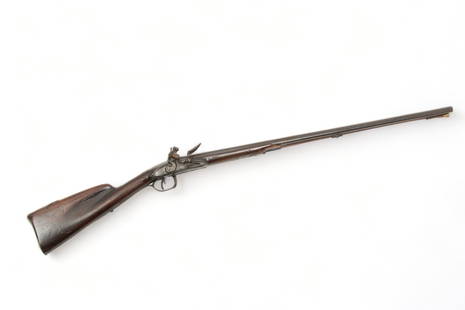
Dec 20, 1772 - The Houndsditch Macaroni Engraving
Similar Sale History
View More Items in Weapons & Armor
Related Weapons & Armor
More Items in Weapons & Armor
View MoreRecommended Collectibles
View More






Item Details
Description
Colonial America
December 20, 1772 "The Houndsditch Macaroni" Engraving
December 20, 1772-Dated Colonial Era, Engraved Parody Caricature Image titled, "The Houndsditch Macaroni," (a fellow who dressed and spoke in an outlandish manner), Crisp Very Fine.
December 20, 1772-Dated Colonial America Period engraved image measuring 10" x 6.75" titled "The Houndsditch Macaroni", with scattered slight foxing well printed on laid period paper. This image was engraved by James Bretherton from a caricature drawn by Henry William Bunbury of a fine fellow in his wig, with tricorn hat and sword walking about. The image is meant to be a parody of the "Macaronies" who would hang around London's Houndsditch area in the mid-eighteenth century. A "Macaroni" was a fellow who dressed and spoke in an outlandish and affected manner, the term quickly becoming associated as a stereotype for inappropriate bourgeois excess and effeminacy. Though the song was taken up enthusiastically by the Americans, the famous line from "Yankee Doodle" where a man "stuck a feather in his cap and called it macaroni" implied that the foolish Yankees believed that a mere feather would be enough to consider oneself a "Macaroni."
A snide looking gentleman in extravagant dress stands with hands in pockets and hat under arm. He looks to the left and sticks his tongue out. He is dressed to parody the costume of the 'macaronies' hanging around London's Houndsditch area in the mid-eighteenth century.
'Macaroni' was a term for the group of highly fashionable individuals who dressed and spoke in an outlandishly affected manner in this period. The term pejoratively refers to a man who exceeded the ordinary bounds of fashion in terms of clothes, fastidious eating, and gambling.
James Bretherton (fl. 1750-1799) was an etcher, dealer and publisher in London. His brother was Charles Bretherton and is particularly associated with Henry William Bunbury, many of whose works he engraved and published. His stock of plates was auctioned in 1799.
Henry William Bunbury (1750"1811) was an English caricaturist. He was the second son of Sir William Bunbury, 5th Baronet, of Mildenhall, Suffolk. He was educated at Westminster School and St Catharine's College, Cambridge, and soon showed a talent for drawing, especially for humorous subjects. His more serious efforts were no great success, but his caricatures are as famous as those of his contemporaries Thomas Rowlandson and James Gillray. His designs were usually etched by Darly and Bretherton, and (from 1780s) Dickinson.
Our Auction Contents:
Black History & Slavery: (Lots 1 - 63)
Abraham Lincoln Related: (Lots 64 - 74)
Historic Autographs: (Lots 75 - 235)
Colonial America: (Lots 236 - 261)
Revolutionary War: (Lots 262 - 304)
George Washington Related: (Lots 305 - 306)
Early American Guns & Weapons: (Lots 307 - 318)
December 20, 1772 "The Houndsditch Macaroni" Engraving
December 20, 1772-Dated Colonial Era, Engraved Parody Caricature Image titled, "The Houndsditch Macaroni," (a fellow who dressed and spoke in an outlandish manner), Crisp Very Fine.
December 20, 1772-Dated Colonial America Period engraved image measuring 10" x 6.75" titled "The Houndsditch Macaroni", with scattered slight foxing well printed on laid period paper. This image was engraved by James Bretherton from a caricature drawn by Henry William Bunbury of a fine fellow in his wig, with tricorn hat and sword walking about. The image is meant to be a parody of the "Macaronies" who would hang around London's Houndsditch area in the mid-eighteenth century. A "Macaroni" was a fellow who dressed and spoke in an outlandish and affected manner, the term quickly becoming associated as a stereotype for inappropriate bourgeois excess and effeminacy. Though the song was taken up enthusiastically by the Americans, the famous line from "Yankee Doodle" where a man "stuck a feather in his cap and called it macaroni" implied that the foolish Yankees believed that a mere feather would be enough to consider oneself a "Macaroni."
A snide looking gentleman in extravagant dress stands with hands in pockets and hat under arm. He looks to the left and sticks his tongue out. He is dressed to parody the costume of the 'macaronies' hanging around London's Houndsditch area in the mid-eighteenth century.
'Macaroni' was a term for the group of highly fashionable individuals who dressed and spoke in an outlandishly affected manner in this period. The term pejoratively refers to a man who exceeded the ordinary bounds of fashion in terms of clothes, fastidious eating, and gambling.
James Bretherton (fl. 1750-1799) was an etcher, dealer and publisher in London. His brother was Charles Bretherton and is particularly associated with Henry William Bunbury, many of whose works he engraved and published. His stock of plates was auctioned in 1799.
Henry William Bunbury (1750"1811) was an English caricaturist. He was the second son of Sir William Bunbury, 5th Baronet, of Mildenhall, Suffolk. He was educated at Westminster School and St Catharine's College, Cambridge, and soon showed a talent for drawing, especially for humorous subjects. His more serious efforts were no great success, but his caricatures are as famous as those of his contemporaries Thomas Rowlandson and James Gillray. His designs were usually etched by Darly and Bretherton, and (from 1780s) Dickinson.
Our Auction Contents:
Black History & Slavery: (Lots 1 - 63)
Abraham Lincoln Related: (Lots 64 - 74)
Historic Autographs: (Lots 75 - 235)
Colonial America: (Lots 236 - 261)
Revolutionary War: (Lots 262 - 304)
George Washington Related: (Lots 305 - 306)
Early American Guns & Weapons: (Lots 307 - 318)
Buyer's Premium
- 25%
Dec 20, 1772 - The Houndsditch Macaroni Engraving
Estimate $400 - $500
1 bidder is watching this item.
Shipping & Pickup Options
Item located in Rancho Santa Fe, CA, usOffers In-House Shipping
Payment

TOP



























![The Little Conjurer Magic Set. Bavaria: Spear [?], ca. 1890...: The Little Conjurer Magic Set. Bavaria: Spear [?], ca. 1890. Large and handsome magic set with wooden and paper props including many mechanical pieces of apparatus, among them a Millet Bell, Dice Vase](https://p1.liveauctioneers.com/928/329228/177514618_1_x.jpg?height=310&quality=70&version=1715272280)






























![[CIVIL WAR]. [BELL, William H., photographer]. CDV of a wounded soldier identified as Private George: [CIVIL WAR]. [BELL, William H., photographer]. CDV of a wounded soldier identified as Private George Ruoss, 7th New York Veteran Infantry, featured naked below the waist. CDV on cardstock mount (light](https://p1.liveauctioneers.com/197/329785/177758300_1_x.jpg?height=310&quality=70&version=1715625218)












